Why haze is an important weather factor? part 1 – types of aerosol and impact on human health
People when checking the weather forecast usually focus on standard weather factors like temperature, pressure, wind, precipitation, and cloud cover. There are weather elements important in our day-to-day life, unlike other elements like dew point temperature, humidity, haze level, etc.
In this article, I would like to describe the importance of haze in forming weather conditions. Even when the Sun is shining and the sky is blue someone (like me) can still complain about the weather because for instance visibility is not good. This weather factor is highly important for mountaineers, who want to see remote mountains. In another case, the haze can disrupt astronomical observations. Poor visibility is also a major problem for many applications of computer vision (Tan, 2008). The visibility issue will be described in a separate article. Here would consider one basic factor, that causes a visual range impairment – the haze. The presence of haze in Earth’s troposphere influences appreciably both sunlight and moonlight dispersing in your surroundings. Aside from the light scattering, sky color changes, and visibility impairment haze has also an important influence on human health. This is one of the pivot issues, that I would like to cover in this part of the whole article.
1. WHAT IS HAZE?
The haze is an atmospheric phenomenon, which is extremely small, suspended in the atmosphere particles (lithometeors, hydrometeors) obscure the clarity of the sky. Due to the extreme smallness of these particles, virtually smaller than the diameter of a human hair (94% of particles of the haze are below 2.5 micrometers in diameter – 30 times smaller than the width of a human hair) and are invisible to the naked eye. As I have mentioned haze consists of lithometeors and hydrometeors.
Lithometors are dry atmospheric suspensions like volcanic ash, dust, sand, and smoke.
Hydrometeors consist of liquid or solid water particles. They may be suspended in the atmosphere or fall through the atmosphere. For hydrometeors, we can classify mist, kinds of fog, precipitation, dew, frost, rime, and spouts. In both lithometeors and hydrometeors, we can classify the particles raised by the wind from the Earth’s surface.
Many of the weather elements identified as hydrometeors are formed by the condensation or sublimation of water vapor in the air or on the surface. Here I will focus on the water droplets, that are suspended in the air. These water droplets determine the air humidity, which we can quantify in three different aspects, of which the most common is relative humidity. The relative humidity says how close is the air to being saturated. When relative humidity is bigger, then the better conditions are to haze concentration through the coagulation or condensation of the smallish particles on water droplets. The coagulation of aerosol particles takes place when aerosols and droplets collide with each other. It results in aggregation and the particle size changes eventually (Pic. 1). Once humidity is bigger the condensation of aerosol particles occurs. Smallish particles stick to the much bigger water droplet being suspended in the atmosphere (Pic. 1).
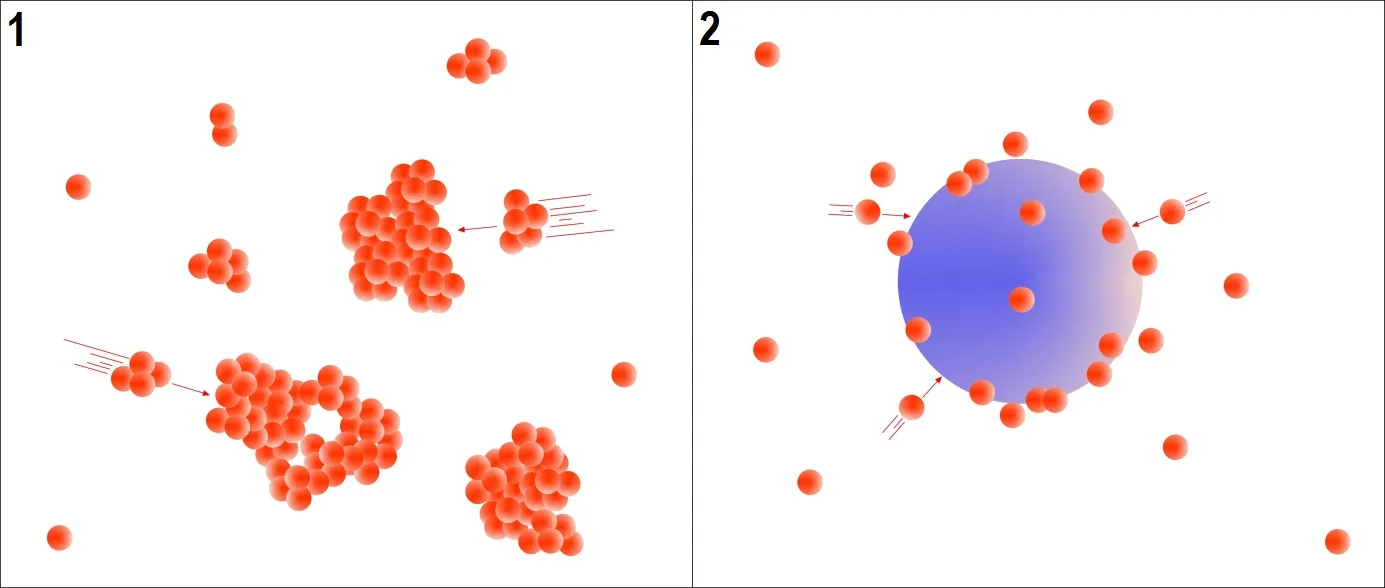
Pic. 1 The behavior of the haze particles depends on the level of humidity: 1 – coagulation of aerosol particles, 2 – condensation of aerosol particles (elte.prompt.hu).
In dry air conditions, haze tends to disappear as long as normal conditions take place. The situation may be different for air-polluted areas.
The lifetime of the aerosol particles in the atmosphere is different. Basically, it depends on their size and level, where are they currently suspended (Pic. 2).
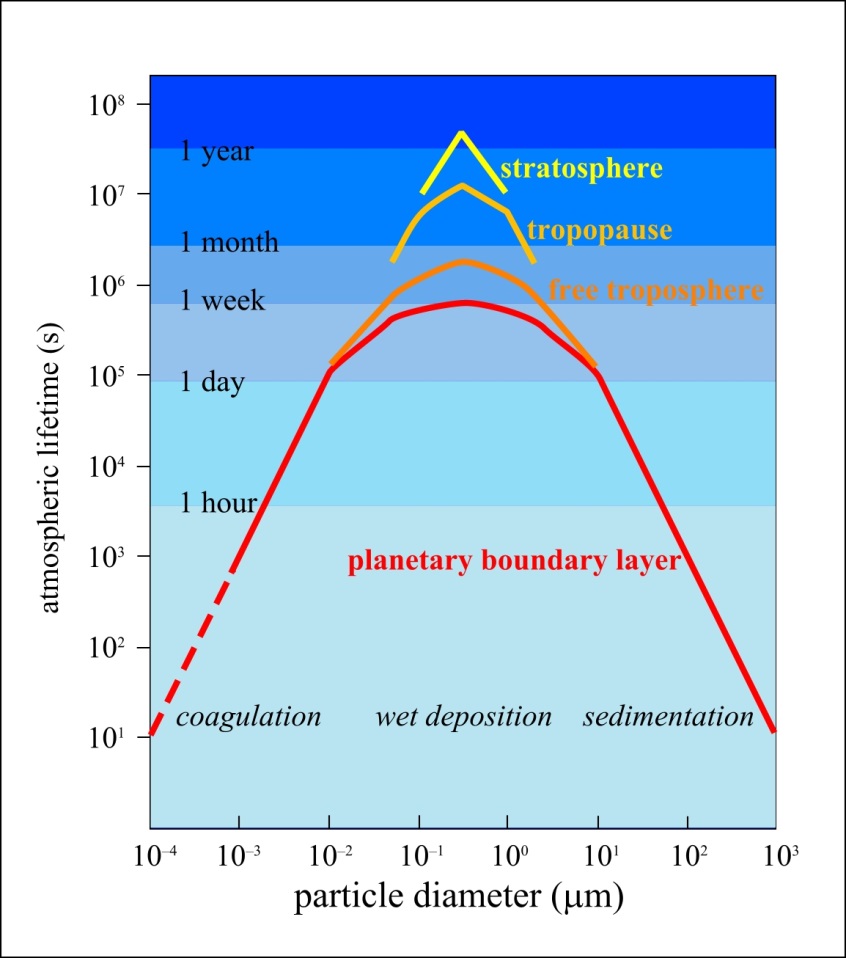
Pic. 2 Atmospheric lifetimes of different-sized particles at different levels of the Atmosphere (Jaenicke, 1980).
We should remember, that not all lithometeors and hydrometeors can be classified as haze because haze is not precipitation, frost, dew, rime, fog, and spout. Haze includes only the smallest particles as I wrote above.
Haze can be generated also by air pollution (smog). That generated haze often occurs, when dust and smoke particles accumulate in relatively dry air. In this situation, when weather conditions block the dispersal of smoke and other pollutants they concentrate and form a usually low-hanging shroud, that impairs visibility. Resuming, the haze has a diverse set of sources including extremely small particles of lithometeors and hydrometeors with also foliage exudations, combustion products, and sea salt (Hidy, 1972). The particles produced by these sources respond quickly to changes in relative humidity and act as nuclei (centers) of small water droplets when the humidity is high. Haze particles are larger than air molecules but smaller than fog droplets (Nayar, Narasimhan, 1999).
Haze gives an opalescent appearance to the sky (Rao, Sethu, 2003). Basically, we can distinguish 3 types of haze:
- Uniform haze, omnipresent inside the planetary boundary layer
- Layered haze, which are pollutants emitted into the atmosphere under stagnant or stable meteorological conditions (Malm, 2016).
- Regional haze escalates recently due to increasing light pollution, where the smog layer spreads into other regions and sometimes even countries.
2. TYPES OF AEROSOL
There are a few types of aerosols depending on the location. We can distinguish:
A) Urban aerosol, which is dominated by anthropogenic sources. The highest concentration takes place during air pollution episodes, especially in the urban areas located in the basin. Highly concentrated particles are blocked by weather conditions and create a thick smog layer.
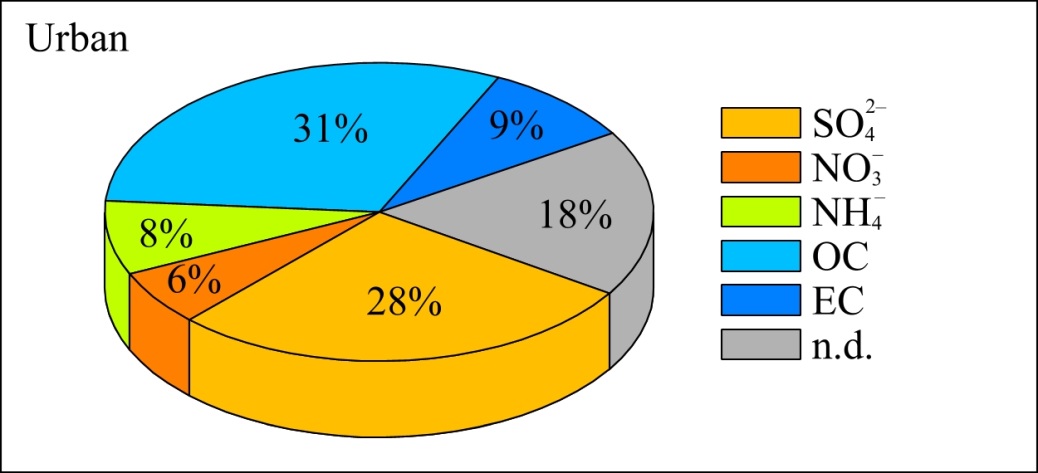
Pic. 3 The chemical composition of the urban aerosols, where OC – organic carbon, EC – elementary carbon (Heitzenberg, 1994) (elte.prompt.hu).
B) Marine aerosol, which constitutes one of the most important natural aerosol systems globally (O’Dowd, Leeuw, 2007). This type of aerosol is created by the interaction of wind stress at the sea or ocean surface. It incurs a bubble-bursting process typically resulting from whitecap generation, where sea-spray particles enslave. When the wind is stronger then marine aerosol is denser. Moreover, a strong wind can generate spume droplet formations, which are bigger particles. Marine aerosol can exist in marine air masses.
C) The rural continental aerosol is typical for rural areas with a faint influence of air pollution. This type of aerosol has mainly natural origin, although recently it has been getting more influenced by fresh anthropogenic emissions (mainly regional and long-range transport). The natural aerosol sources contain around 30% primary biological material (Hock et al, 2008).
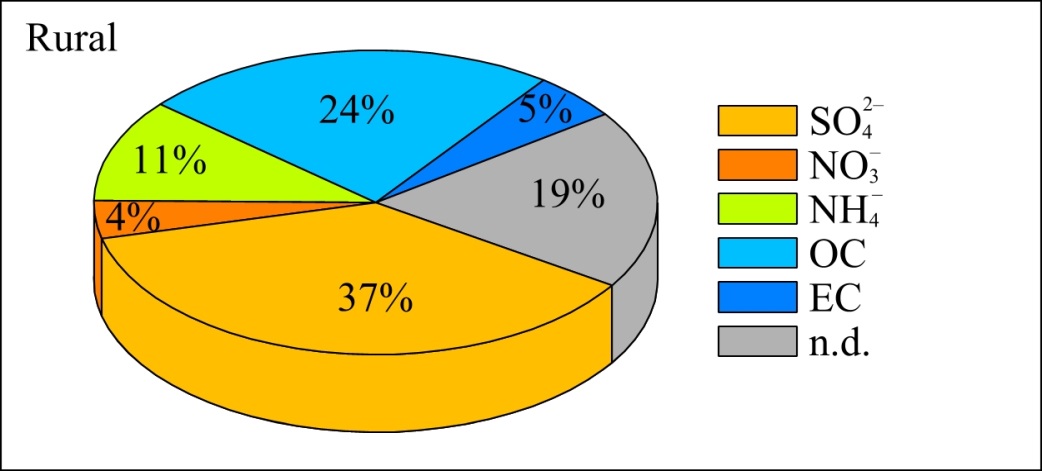
Pic. 4 The chemical composition of the rural aerosols, where OC – organic carbon, EC – elementary carbon (Heitzenberg, 1994)(elte.prompt.hu).
D) The remote continental aerosol is typical for continental air masses and inland regions. The air contains mainly dust, pollen, and organic particles. Generally in this type, lithometeors prevail due to mostly dry surfaces, which simplifies raising them by the wind from the ground. The sand particles are to be seen quite often.
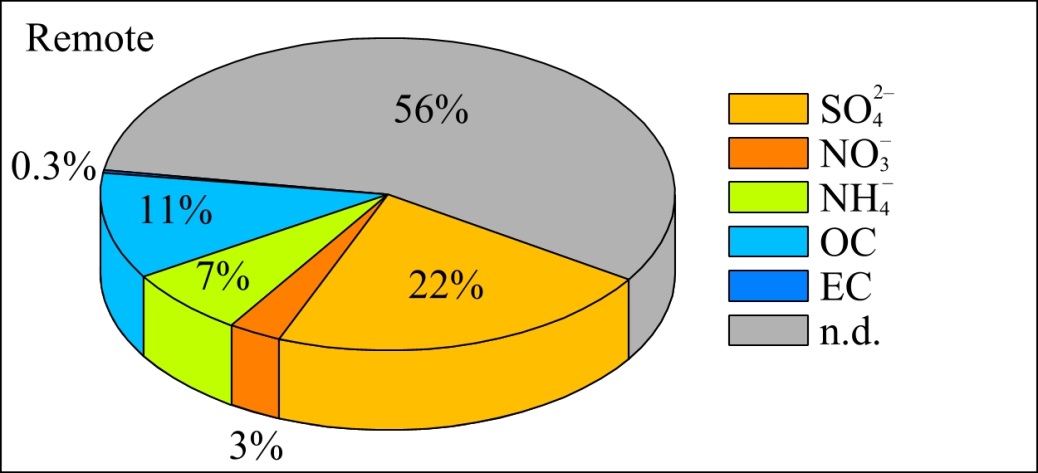
Pic. 5 The chemical composition of the remote continental aerosols, where OC – organic carbon, EC – elementary carbon (Heitzenberg, 1994)(elte.prompt.hu).
E) The free tropospheric aerosol is to be found in the mid and upper troposphere above the cloud level. This type of aerosol can develop in low-temperature conditions
F) Polar aerosols so-called “Arctic haze”, which was suggested to originate from anthropogenic emissions in northern midlatitudes (Pandis, Pandis, 2016). This type of aerosol increases in winter and early spring (February to April) each year (Pandis, Seinfeld, 2016). Aside from anthropogenic substances, this aerosol contains sea salt, dust, and organic matter.
G) Desert aerosol is a long-range transport type of aerosol with the biggest contribution of sand and dust. This type of aerosol has the biggest size of particles. Extremely dry areas make favorable conditions for rising dust particles even by the weak wind. In more windy conditions these particles are transported far, even on different continents.

Pic. 6 A good example of desert aerosols transported by wind from the Sahara to South-East Europe (Severe Weather Europe).

Pic. 7 A dust storm in March 2018 at Heraklion in Crete, extremely high density of desert aerosols (forfun.com).
3. HAZE IMPACT ON HUMAN HEALTH
Haze can have a considerable impact on health, especially in polluted areas. The most visible health defect caused by air pollution includes difficulty in breathing, wheezing, cough, and asthma. In the next step, it leads to the worsening of existing respiratory and cardiac conditions.
Due to its extremely small size, the haze particles can bypass normal body defense and penetrate deep into the lungs. When inhaled, they can enter the bloodstream and get absorbed by underlying tissue, potentially interacting with other compounds and substances in the body. We can distinguish short-term and long-term haze effects.
Short-term haze effects are to be observed just after the contact with polluted air. Depending on how sensitive you are, the severity of the haze, and the time of exposure you may experience some adverse short-term haze effects. The first symptoms may be visible for up to 1-3 days of time. People sometimes can not be aware, that their suffering can be associated with haze concentration. The aerosols can easily be inhaled into our lungs giving us symptoms such as cough, wheezing, shortness of breath, and a feeling of tiredness and weakness. Common can be also eye irritation or watering eyes. These symbols are usually mild and will subside when you stay indoors and limit your exposure to haze. During dusty conditions, we can be liable for asthma. Both dust and air pollution may cause irritation of the nose and throat in healthy individuals.
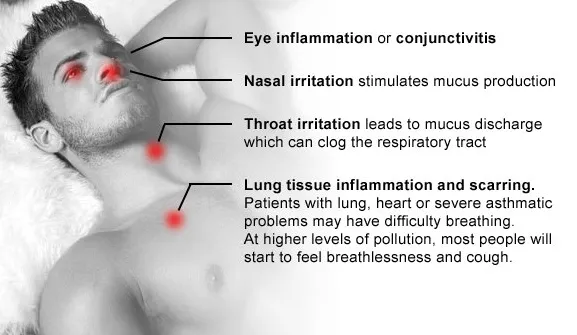
Pic. 8 A short-term haze impact on human health (blissair.com).
Long-term exposure to haze and particulate matter can lead to the development of medical conditions such as bronchitis and a higher incidence of lung cancer. People can feel a headache, decreased lung function depressed respiratory immune defenses, chest pain sometimes also diarrhea or stomach upset. Moreover stress and depression and insomnia. Long-term exposure to air pollution particles increases the risk of death by cardiovascular disease and reduces life expectancy by several months to a few years.
The long-term haze effects on health can be considered for every period of human life. Yet in antenatal life when the mother breathes toxic air the fetus can be threatened by being underweight, chromosomal abnormalities, and many defects, even death as well as in newborns. In China every 30 seconds a baby is born with some physical defects. The most common effects in order to frequency are cleft lip, heart disease, and hydrocephalus. The amount of newborn defects caused by polluted air constantly increases both in urban and rural areas. In another group of age, for instance, during childhood and adolescence, air pollution can lead to diminished mental capacity and increased risk of brain damage. Polluted air has also a negative effect on central nervous system functionality.
Air pollution can be outdoor and indoor. Outdoor air pollution is a really big problem for the most populated regions, mainly in Eastern Asia. The world’s most air-polluted city is New Delhi, where 90% of people are affected by pollutants. There are other places, where air pollution is big, like Jakarta, Kampala, central Iran, Peshawar, and at least several others. Nowadays many air quality maps are available around the world to check the air quality in your area. One of the examples I would like to show is below (Pic. 9, Pic. 10).
A multitude of air quality forecasts is also available for Android, but this is a topic for another article.
Important is also indoor air pollution, which contains harmful chemicals coming from or accumulating inside the building. The best example of indoor air pollution we can find during the colder season. Heating a house by burning e.g. wood and coal can contaminate the air inside the house. Ash and smoke can make breathing difficult and also stick to the walls and other objects in the house. Another culprit is mold, caused by too much humidity inside the building. The spores of mold become a part of the air, and being inhaled by the human organism can cause sickness and allergy.
Now we know what exactly causes air pollution. We know also the regions, where air pollution is the highest. It’s a good time to wonder how air quality can be measured in our area.
An Air Quality Index (AQI) is commonly used to indicate the number of pollutants in the air over a specified period of time. Air quality index values are usually grouped into ranges. Each range is assigned a description or severity, color code, and a cautionary statement. Given an air quality index value, you can get a general knowledge about the air quality in your area. Generally, the severity of haze is determined by the Pollutant Standard Index (PSI), which takes into account 6 air pollutants. Important is the 24-hour PSI, which is derived by taking the average of data collected from the past 24 hours and indicates the air quality impact on human health (Pic. 11).

Pic. 11 The 24-hour PSI air quality index (RafflesMedicalGroup.com).
Haze impact is negative not for humans only but also for the whole environment. Entire ecosystems suffer from a high level of air pollution. Haze can muffle sound and obscure shapes and colors. Haze can also directly contaminate the surface of bodies, water, and soil. Haze is also a reason for acid rains, that kill the trees.

Pic. 12 The forest was destroyed by acid rain. Łomniczanka valley, Karkonoski National Park, Poland.
Acid rain forms from the mixture of water and oxygen in the atmosphere with sulfur dioxide and nitrogen oxide coming from coal-fired power plants and motor vehicles. Acid rain is killing not only plants but also soils, changing their composition and also buildings and monuments because leads them to decay. Like humans, animals are also exposed to air pollution, which causes lower reproductive rates, birth defects, and diseases. Air pollution causes also global warming.
Everyone can take steps to reduce air pollution. The idea is very simple. People should take public transport rather than use their own cars, especially when they commute to work alone. Moreover, cars should be superseded by bikes. During the winter season, people should resign from heating their houses with coal and start to use gas. The smog combined with the thermal inversion can be really dangerous for people in any group of age. Another solution could be recycling grass and yard trimming instead of burning them.

Pic. 13 Air pollution seen above the Jeleniogórska Basin in Poland, which in this case is caused by using coal and wood in heating the houses.
If we have to live in an area with a high level of air pollution we should definitely protect our airways and breathe through a mask. The best are N95 masks (Pic. 13).

Pic. 14 N95 masks, which are at least 95% efficient against fine particles about 0.1 – 0.3 microns and 99.5% efficient against particles about 0.75 microns or larger (Moh.gov.sg).
This is the first part of the article, where I have described the haze’s impact on human life and the environment briefly. Traditionally there are a lot of things, that possibly can be developed in future articles. Anyway, I hope, that I have shown you the big importance of haze, which probably you couldn’t realize before.
Mariusz Krukar
References:
- Heitzenberg J., 1994, The life cycle of the atmospheric aerosol (in:) Topics in atmospheric and interstellar physic and chemistry, p. 251 -270
- Hidy G.M., 1972, Aerosols and atmospheric chemistry, Academic Press, New York.
- Hock N., et al., 2008, Rural continental aerosols properties and processes observed during the Hohenpeissenberg Aerosol Characterization Experiment (HAZE2002), (in:) Atmosphere, Chemistry, Physics vol.8, p.603-623.
- Jaenicke R., 1980, Atmospheric aerosol and climate, (in:) Aerosol Sciences, vol. 11, p. 577 – 588.
- Malm C., W., 2016, Visibility: The seeing of near and distant landscape features, Elsevier Inc., Oxford.
- Nayar K.S., Narasimhan G., 1999, Vision in bad weather, Columbia University, New York.
- O’Dowd C.D., Leeuw G., 2007, Marine aerosol production: a review of the current knowledge, (in:) Philosphicl transactions of the Royal Society.
- Rao G.V., Sethu R., Singh M., P., 2003, Air Quality, Birkhauser Verlag, Basel
- Seinfield J.H., Pandis S.N., 2016, Atmospheric chemistry and physics: from air pollution to climate change, John Wiley & Sons, New Jersey
- Sinclair D., Richard J., 1974, Effect of relative humidity on the size of atmospheric aerosol particles, (in:) Atmospheric Environment, vol. 8 i.11, p.1111 – 1117.
- Tan R., T, 2008, Visibility in bad weather from a single image, Imperial College, London
Links:
- Physical and chemical characteristic of aerosols
- Haze – definition, explanation
- Britannica.com: the Earth’s atmosphere
- The effects of haze on your health
- Cloudatlas.wmo.int: Hydrometeors
- Cloudatlas.wmo.int: lithometeors.html
- Kinds of the humidity measurements
- Health effects of haze
- Air pollution map by country – fine particulate matter
- In China, pollution causes two birth defects a minute official
- https://www.haze.gov.sg/
- Worlds air pollution: Real-time air quality index
- World’s the most air polluted city
- The most air-polluted cities in the World
- All about air pollution
- Haze and health effect
Wiki:

